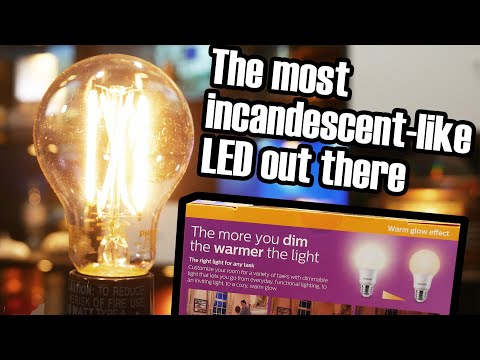Is Philips discontinuing their coolest warmest product?

I have something like five video topics that have half-baked sorta-started scripts and it’s driving me up the wall a little bit so here’s a hastily thrown-together script brought to you by a disappointing tript to home depot, he quipped. Philips, and this is not sponsored in any way which will become increasingly clear as I get more and more upset with them, makes what is to me the holy grail of dimmable LED light bulb. They call the feature I’ve grown to love the “Warm Glow effect” and the idea is that these can rather faithfully mimic the shifting color temperature of an incandescent light bulb as it’s dimmed. Here, take a look; Dimmer, warmer! Brighter, less warm. Kinda dim, kinda warm.
Really dim, really warm. I know I’m old fashioned, but this is exactly the sort of thing I want my light bulbs to do. See, back when hot glowy wires were the norm, a dimmer switch would cause the light output of a tungsten lamp to shift downward from its 2700 kelvin (or maybe 3000 kelvin in the case of halogen) color temperature into a progressively warmer-looking color as brightness was reduced.
This happened because the filament was in fact getting cooler, and yes the fact that we describe cooler literal temperatures as warmer color temperatures does rile some folks up a bit but language doesn’t have to be scientifically precise. Except, of course, when I say it does. Anyway, in an incandescent lamp, the apparent color temperature is a result of the filament’s literal, actual temperature because the fantastically hot filament is essentially a blackbody radiator. We call this a 2700K color temp because that filament is 2700 kelvins hot, or 2462 Celsius hot, or 4400 Fahrenhot. When you run one on a dimmer switch and limit the power going to the lamp, the filament gets less hot, resulting in not only less light but also warmer-looking light. Because again, the color temperature is a function of the filament’s actual temperature.
At very low light levels, the color is almost an amber, not far off from candlelight. And when I want to rest my eyes in a dimly-lit environment, that’s exactly the sorta thing I’m looking for. If you know anything about my Christmas light shenanigans, it probably won’t surprise you to learn that my biggest issue with LED lighting as it was first hitting the scene was that, even once we got dimming pretty-well figured out the dimming experience always seemed wrong to me.
Side-note, this isn’t a video on how dimmer switches work, but as a brief summary dimmer switches repeatedly chop up the AC sine wave as it goes through them because that’s really the only efficient way to throttle output power. While that approach was fine for incandescent lamps, when dimmable CFLs and LEDs appeared, which both have electronic drivers to control the glowy bits, well it required some careful circuit design in order for these new lamps to A) work correctly with that gnarly chopped up power and B) interpret its relative choppiness as a desired brightness output. The fact that dimmable LED bulbs manage to work at all on this wacky power is pretty impressive if you ask me, although lots of older dimmer switches themselves couldn’t handle the strange load characteristics of these newfangled lamps and that’s why the dimmability of LEDs is still a sore spots for some folks as you may have needed to replace some dimmer switches if you had a flickerfest. If you haven’t looked into this in a long time, LED-compatible dimmers are pretty cheap these days and so long as you’re comfortable swapping one out, I promise the energy savings are gonna pay for that new dimmer switch pretty quick. Uh, right, so even once we got dimmable LEDs working well with dimmer switches, they never looked right to me at low brightness levels because, without getting warmer like an incandescent bulb does, a warm-white balanced LED starts to look almost… grey when you get down below 25% brightness or so. It’s nice that it’s less light, but there was no way I could rewire my brain to accept that as anything but “wrong.”
So it was a glorious day when I first laid eyes on the “Warm Glow” packaging, saw the little picture Philips put together and realized “Holy crap they’ve done it. This I’ve gotta try!” and I bought a couple, took ‘em home, and was hooked. Finally, an LED light bulb that truly looks and behaves like an incandescent lamp, bringing all of the tech’s advantages with virtually none of the downsides. While you weren’t looking, I put a Warm Glow bulb in here.
That’s right. This guy. Is. Not. Incandescent. That was a really smooth reveal. That was quite some time ago.
Philips has been making these for… gosh close to a decade now I think, I know for a fact I bought a bunch back in 2016 including this one right here. And I had a pretty good guess into how they worked - it seemed like there were probably two sets of diodes, perhaps balanced at 3000 kelvin and 2100 kelvin, and at full brightness they mixed together to make what looked like 2700 kelvin. Then, as the bulb dimmed, it would first lower the output of the cooler LEDs, gradually shifting the color temperature down, until finally only the warm set was lit. It could then still get a bit dimmer but that’s as warm as it’ll get. Lately they started producing filament style bulbs with the warm glow effect which reveal that, sure enough, that’s exactly how this works. You can even see when the bulb isn’t lit that two of the filament sticks are a bit paler than the other two.
In case you weren’t aware, modern white LEDs are actually not too far off from fluorescent lighting tech as the diodes emit blue light - or, as is increasingly common, near-UV light - which is then converted by a phosphor mix sitting on top of the diodes into other wavelengths of light. When that's all combined it produces a white light - at least, one that’s good enough for our eyes, anyway. Generally, LEDs with a warm color temperature have a very deep yellow, almost orange phosphor coating, and as you move up the color temperature scale the phosphors become an increasingly pale yellow. Take a look at one of these video lights, which have a matrix of warm white, cool white, and RGB diodes and it’s obvious which diodes are which. So, as predicted, at full brightness all of the filament sticks are lit. And as the light is dimmed, at first only two of the filament sticks (the cooler-looking ones) start to get dimmer.
Since, as that happens, an increasingly greater proportion of the total light output is coming from the still-bright, warmer filasticks, the mixed light output appears progressively warmer. At least, to a point. Once the cooler filasticks are completely extinguished, it can’t get any warmer but it will get dimmer. In fact these will just barely glow if you want them to.
At first I thought this idea would be a poor fit for these filament-style bulbs, and it does look a little weird to have only half of them doing anything at low brightness, but given how this style of bulb isn’t exactly easy to stare at anyway, I think it’s fine. And actually, once they started making these the last meaningful differences between incandescent and LED were all but eliminated. I have been extremely pleased with these LED lamps since I first discovered them. They’ve performed excellently and flicker-free on nearly every dimmer switch I’ve tried, although I have had some flickering on certain switches but it generally happens only at very specific brightness values. Also, they have a great light quality to them; not exceptionally good but certainly better than average.
And in all this time, if memory serves, I’ve had exactly three failures: The worst one was a bule that just died about a year after I started using it. And then there's this one. Uh, this one seems to have some sort of wiring problem because at full brightness, it can get a little flickery. And I just discovered (literally just now) that at low brightness settings, it's not doing the dimming effect correctly. All of the filmanet sticks are working together. And then the other failure, I think, was just a hilarious manufacturing boo-boo.
I have a frosted glass bulb version of this bulb and it works absolutely fine but… it doesn’t get warmer! It's just a wee bit cooler-looking than the package mate it came with so I think that one got made with all-cool filasticks. I’d show it to you but I can’t find it. Oops. Aside from those three failed lamps, there is literally just one other problem I’ve ever had with these and it’s, again, minor. But… weird.
I have a few of these PAR20 lamps in recessed cans and all of them handle the transition from cool to warm a little bit wrongly. If you start out at full brightness, they’re perfect! But if you dim them down to a certain point, even though it starts out mixed correctly the bulbs will slowly just… stop outputting any light from the cool diodes and go full-warm. It took me a while to realize this was happening because it occurs over a period of several seconds and they all do it in precisely the same way - I have four of them on the same switch and they behave identically. In fact I’ve got another pair on a different switch from a different manufacturer and yep, same exact thing.
In fact that assured me it wasn’t the switch drifting a bit as I thought, it’s definitely a flaw in that bulb’s driver design, but since it’s really only a problem around a relatively narrow dimness band, I’ll give it a pass. It’s just… pretty weird. Now, I said that I’m making this video thanks to a disappointing trip to Home Depot. In my area, and maybe this is nationwide, I dunno, the different hardware stores seem to have exclusive deals with certain lighting brands. My Mostly Midwestern Mega Merchandise Mecca, Menards, doesn’t sell Philips bulbs at all.
They sell mainly Sylvania - and they’re gonna come up later. I think Lowe’s sells mainly GE bulbs from what I remember. And wherever else you might find a light bulb tends to have a mishmash of whatever, really. Anyway, the important thing is that the Orange Store has been the place I needed to go to get these or really any Philips lighting products. And I made a trip to the Orange Store to get a few of these for some new lamps of mine and there were none to be found.
No shelf space in that entire store was devoted to my favorite, fantastic Philips flight bulbs. No matter, I have Internet. That was pretty fruitful but the pickin’s are getting increasingly slim. There are nowhere near as many varieties available as there used to be, and a ton of what shows up is out of stock. Not long ago Philips was putting this tech into pretty much any kind of lamp you could think of, from your basic A19 things, to candelabra-type bulbs, frosted floods and PAR lamps, and even GU10 halogen replacements! In fact, they even sold those fancy LED trim retrofits meant to go in can lights with the Warm Glow effect. I’ve got some of ‘em and they’re great! But these days? Well, they seem to be an endangered species.
Even Philps’ own website isn’t helping things. Yeah, they still have a page for the product, but you click on the link to browse and… well this is useless. Lots of these are clearly not Warm Glow capable - anything daylight balanced surely isn’t, and looking through the filters on the left - yep, there’s nothing there specifically for this feature. So what in the heck is goin’ on? It can’t just be you weirdos who like daylight-balanced lighting, I mean plenty of soft white bulbs are still for sale and any remotely nice one will be dimmable.
It’s pretty much just the contractor grade stuff that isn’t these days. Well, I don’t know. But I can guess! There is of course the whole global supply chain stuff we’re still dealing with but I don’t think that can quite explain this. As recently as January I ran into a couple of Home Depot stores and they both had a solid selection. Although I’ll be honest I got inklings of trouble since I couldn’t find a ceiling fan bulb with Warm Glow which was why I went in there in the first place.
I feel as though since the Orange Store had just six months ago committed a good section of the light bulb aisle to these bulbs that supply chain stuff is unlikely. What I think is far more likely to be the case is that dang smart stuff all the kids are into these days. I think it was an inside job. [whispers angrily] Hue did this! Philips has definitely been pushing their Hue line of smart whatevers (and plenty of non-Hue smart whatevers it seems) and while they coexisted in harmony with Warm Glow for quite a few years, I’m thinking Philips is gonna make the folks like me who are just a little bit too anal about our lighting invest in something like their “tunable white” bulbs.
Actually, I can’t tell if they get any warmer than 2700K, so I might even need to get one of those full color ones and get all fiddly with an app or some junk. Now lest you think I’m going into this future all kicking and screaming… well I am. A little bit. But I actually have a lot of smart lighting stuff and have for years, but I am on team “smarten the switches, not the bulbs.” I have bought a grand total of two Smart Bulbs in my entirely life, one of which never got used. You can find a really old video of mine where I went into home automation stuff back in like 2017 - oh actually it was December of 2016, holy cow. And in it I talked about my Z-wave dimmer switches, all of which I’m still using by the way! Z-wave and Zigbee are two communications protocols made specifically for home automation stuff, and the really neat thing about those protocols is that none of my smart switches or sensors even know what the Internet is.
My entire smart home has one device connected to the internet, not counting smart speakers, and that’s the hub which actually processes commands and coordinates all those switches. That’s the last I’ll speak on the... matter, though as the smart home landscape is in the process of changing, and hopefully to something simpler and better. I just wish Z-wave and Zigbee were more widely understood as the internet-optional ecosystems that they are. Needing a hub is actually a very good thing, especially when it comes to network security, but nobody ever communicated that very well. Still, I’m not anti-smart bulb, for what it’s worth.
Installing a light switch can be intimidating and most smart switches need a neutral wire to function, which many older homes didn’t run through the switch boxes. And indeed some rather new homes as I’ve recently discovered. But all I’ve ever wanted with my home automation, at least in the realm of lighting, is to have control over brightness. And since a light switch is usually in control of at least a few light sockets, it was MUCH cheaper for me to install smart switches than it was to buy smart bulbs. Anyway, while I don’t care to have control over the color of my light bulbs or anything like that I do want them to mimic incandescent lights as closely as possible, and the Warm Glow bulb was an elegant - and also pretty cheap! - means to that end. The new tunable white options are interesting… but here’s the thing.
I never want daylight balanced lighting in my home. I know that lots of people find it useful, and I can see the value of a light bulb which shifts the color temp throughout the day; being daylight balanced when the sun’s up, and nice and warm when it’s not. For me personally, though, that just doesn’t have much value to me. I know not everyone has enough natural light in their home to do this but, I generally don’t need the lights on at all when the sun is up. And to be honest, on dismal overcast days I actually find the warmth of incandescent-balanced light to be soothing and cozy.
For that reason, a bulb with daylight and soft white diodes would be half wasted on me. I suppose if it had a super-warm set of diodes, too, and could still do a warm-glow-like effect that would be neat, but once you get that complicated you might as well just make the thing a smart bulb. And that’s why I appreciate these so much. It’s a cheap, simple, and elegant tweak to the dimmable LED concept, adding that subtle but very important effect back into a modern, efficient light bulb. That’s all I was ever asking for, and dangit if we’re gonna lose this option to smarter, connected light bulbs I’ll be upset.
And that's why I bought all these and stocked up. Philips, YOU ARE NOT TAKING THIS AWAY FROM ME Oh, right, Sylvania. I said they were gonna come up.
For a short while, Sylvania was copying this idea. They called it “premium dimming” or something like that; I only remember seeing them a few years ago, and I never bought any to compare to Philips. There are a few new-old-stock options out there, but it doesn’t look like they’re still in production. Again. Boo! I’d be curious to know if people just don’t understand what this feature is or knew to look out for it.
There are enough people that just don’t care about color temperature at all - I mean, if there’s one thing that offends me more than a daylight-balanced light bulb in a bedroom, it’s mixed color temperatures in the same room (or worse, fixture) Yet there’s a ton of folks out there who truly don’t care about that. Maybe they can't see it. I dunno, I don’t know how they can look past a fixture riddled with a hodgepodge of different color lighting in it but oh well. They do. Are these light bulbs for everyone? No. If you don’t like warm lighting, they’re definitely not for you. But for those of us somewhere in between fuddy-duddy and smart home enthusiast, they’re great.
Philips, if you're listening, please don’t stop production of these. I hope this is just a supply chain hiccup, but I’m honestly not holding my breath. Whoever was first responsible for these, thank you so much for your efforts. I truly have never been happier with a lighting product.
And, I’ve converted a fair share of LED skeptics by convincing them to try a Warm Glow bulb. These are really so close to incandescent dimming in their behavior and appearance, and if that’s your jam these are your bulbs. Anyway, that’s all. These bulbs have come up in the past a few times on the channel but I’ve never bothered making a video specifically about them. And frankly, I wasn’t planning on it.
But now that it looks like they might be an endangered species, well I mean I couldn’t just sit here and do nothing! I suppose it’s very possible that dimmer switches are just far more of a niche thing than I realized. Certainly I can think of plenty of environments without them. And, uh, now that I think about it, I imagine most rental apartments don’t offer them.
So maybe that’s what’s going on here. Smart bulbs are a nice way to add dimming, remote control, and more with little hassle. Still, Philips was putting this tech in to such a wide variety of products not that long ago that I think dimmers can’t be *that* niche, can they? Oh, and I didn’t even mention the really irritating thing which is that, now that I mostly have to buy these online, I’m not getting those great time-of-sale rebates my utility offers on LED bulbs.
It’s a good thing these have proven to be so reliable overall. Oh and might I suggest, if you’re looking to add some dimming in your life, you should look at these plug-in dimmers for lamps. Sure, they don’t help with any permanent lighting in your home, but a few lamps here and there can make a big difference to a space. Plus, lots of these have smart functions! I’ve been using a Z-wave enabled dimmer for this video. Usually I try to think of some sort of real ending before I c ♫ endangeredly smooth jazz ♫ They call the feature… that’s the wrong box! You did this to yourself.
We call this a 2700K color temperature because… (laughs) You gotta pick it up a little higher there, buddy! That’s exactly how this happens. You can even see when the bulb isn’t lit… why did I say “happens?” That’s not what the s… that’s not what it says. And in all this time, if memory serves, I’ve had exactly two failures.
I just remembered a third one. And as I made a trip to the Orange Store to get a few for some new lamps of mine. Well… that’s not the words that are there. [fart sound] Man, I forgot to move the frame for that blooper where I bonked the lampshade. That's gonna haunt me forever.
OK, well not for that long. But I hope this video haunts Philips execs forever! Unless of course they keep this product line going. Then I will revoke the haunt.
2022-06-23 19:58


